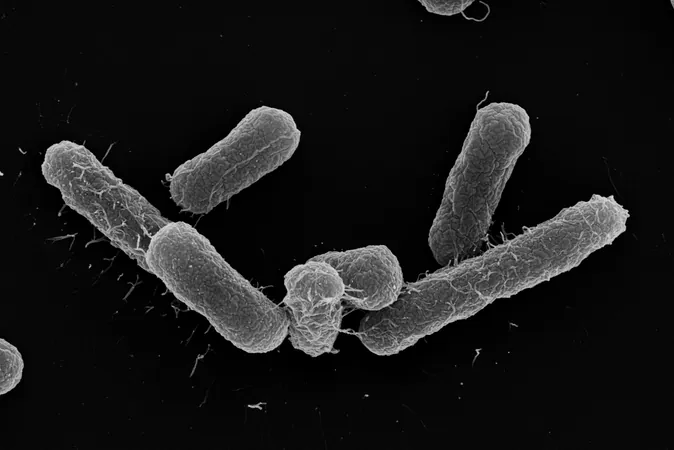
Ancient Viral DNA Unveils Secrets of Early Embryo Development
2025-01-20
Author: Emma
Unraveling the Mysteries of Transposable Elements
Recent research has shed light on the enigmatic role of transposable elements—fragments of ancient viral DNA—in early embryo development. During the critical hours and days post-fertilization, these elements are reactivated, highlighting a phase characterized by the remarkable adaptability of embryonic cells. However, the intricacies of the molecular mechanisms and regulatory factors that modulate this plasticity remain largely unexplored.
Studies conducted with various model organisms, particularly mice, have suggested that these transposable elements may play a crucial role in cellular adaptability, yet there is still uncertainty about whether this phenomenon is universally applicable to all mammals. The evolutionary background of these viral remnants leads to further inquiries about their conservation across different mammalian genomes. Clarity on the regulatory mechanisms that govern the activation of transposable elements could have significant implications for advances in reproductive medicine and the broader understanding of genome regulation.
Revealing Extinct Viral Elements in Embryos
A groundbreaking study led by Prof. Maria-Elena Torres-Padilla at Helmholtz Munich and LMU investigates these ancient DNA sequences through a novel transcription analysis method. By creating a comprehensive atlas of single embryos from several mammalian species—including mouse, cow, pig, rabbit, and the non-human primate, rhesus macaque—the team made astonishing discoveries. They found that ancient viral elements, previously deemed extinct, are remarkably re-expressed in mammalian embryos, with each species expressing distinct variants of these elements.
Implications for Gene Manipulation and Cellular Research
This research underscores that the activation of transposable elements is a conserved phenomenon across different species. Identifying specific elements not only opens the door to innovative gene manipulation techniques but also facilitates the simultaneous targeting of numerous genes in cellular contexts. Dr. Marlies Oomen, a co-first author, states, "Our findings present a new avenue to influence cell fate, such as steering stem cell differentiation, which traditionally demands the concurrent manipulation of hundreds of genes." Such breakthroughs emphasize the need to delve deeper into the regulatory frameworks behind these transposable elements.
Prof. Torres-Padilla elaborates further, explaining the significance of their findings: "Transposable element activation emerges as a hallmark of early embryonic development in multiple mammalian species. This is crucial, as these early cells have the potential to differentiate into all types of body cells. By deciphering how these cells regulate ancient viral elements, we gain critical insights into the underpinnings of cellular plasticity. Our study paves the way for future research into specific regulatory mechanisms, which holds promise for advancements in health and disease management."
A Comprehensive Dataset for Developmental Biology
In addition to introducing a pioneering methodology for analyzing embryonic development, this study has produced an invaluable dataset spanning multiple mammalian species. Early development is a complex and dynamic process that garners much scientific interest; however, many previous studies focused solely on a single species, typically mice or humans. This multi-species approach enables researchers to pinpoint key regulatory pathways that are common across mammals, offering rich biological insights. The dataset generated from this research is poised to become an essential resource for scientists specializing in developmental and reproductive biology, fostering further exploration and discovery in this fascinating field.
Stay Informed!
For those eager to keep abreast of cutting-edge research and scientific breakthroughs, subscribing to reputable science newsletters can provide daily updates directly to your inbox, ensuring you never miss out on significant developments shaping our understanding of life sciences!









 Brasil (PT)
Brasil (PT)
 Canada (EN)
Canada (EN)
 Chile (ES)
Chile (ES)
 Česko (CS)
Česko (CS)
 대한민국 (KO)
대한민국 (KO)
 España (ES)
España (ES)
 France (FR)
France (FR)
 Hong Kong (EN)
Hong Kong (EN)
 Italia (IT)
Italia (IT)
 日本 (JA)
日本 (JA)
 Magyarország (HU)
Magyarország (HU)
 Norge (NO)
Norge (NO)
 Polska (PL)
Polska (PL)
 Schweiz (DE)
Schweiz (DE)
 Singapore (EN)
Singapore (EN)
 Sverige (SV)
Sverige (SV)
 Suomi (FI)
Suomi (FI)
 Türkiye (TR)
Türkiye (TR)
 الإمارات العربية المتحدة (AR)
الإمارات العربية المتحدة (AR)